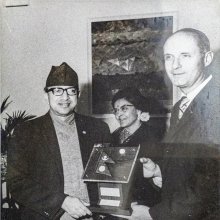Calaka: 12 definitions
Introduction:
Calaka means something in Buddhism, Pali, Hinduism, Sanskrit, Marathi, Hindi, Tamil. If you want to know the exact meaning, history, etymology or English translation of this term then check out the descriptions on this page. Add your comment or reference to a book if you want to contribute to this summary article.
Alternative spellings of this word include Chalaka.
Images (photo gallery)
In Buddhism
Theravada (major branch of Buddhism)
Source: Pali Kanon: Pali Proper NamesSee Talata.
Theravāda is a major branch of Buddhism having the the Pali canon (tipitaka) as their canonical literature, which includes the vinaya-pitaka (monastic rules), the sutta-pitaka (Buddhist sermons) and the abhidhamma-pitaka (philosophy and psychology).
Languages of India and abroad
Pali-English dictionary
Source: Sutta: The Pali Text Society's Pali-English Dictionary1) Calaka, 2 (nt.) (perhaps from carv to chew; but Sk. carvana, chewing, is not found in the specific sense of P. calaka. Cp. ucchiṭṭha and cuṇṇa) a piece of meat thrown away after having been chewed Vin. II, 115; IV, 266 (=vighāsa); VvA. 222 (°aṭṭhikāni meat-remnants & bones). (Page 263)
2) Calaka, 1 (m.) a camp marshal, adjutant D. I, 51≈(in list of various occupations); A. IV, 107 sq. (Page 263)

Pali is the language of the Tipiṭaka, which is the sacred canon of Theravāda Buddhism and contains much of the Buddha’s speech. Closeley related to Sanskrit, both languages are used interchangeably between religions.
Marathi-English dictionary
Source: DDSA: The Molesworth Marathi and English Dictionarycalāka (चलाक) [or ख, kha].—a ( P) Smart, active, agile, brisk.
--- OR ---
caḷaka (चळक).—f A troop, company, band, body. 2 A discharge or fall of rain, a heavy shower. v yē, paḍa. 3 A forceful gush (of any liquid): a vehement rush (of horsemen, men, cattle, dogs). 4 (Commonly caḷatha) A pile.
--- OR ---
cālaka (चालक).—a (cāla) Swift-going, fleet, quick. 2 (S) That sets in motion: also that moves, carries on, conducts.
--- OR ---
cāḷaka (चाळक).—a (caḷā) Mischievous, full of tricks, pranks, and frolics. 2 Full of blandishments and soft arts--a woman. See cāḷaka bhavānī.
--- OR ---
cāḷaka (चाळक).—a (cālaka S) That sets in motion; or that keeps going, carries on &c. In comp. as cakracāḷaka, viśvacāḷaka, cittacāḷaka, buddhicāḷaka.
--- OR ---
caḷaka (चळक).—. Add:--5 The fusing or beginning to run (of gold &c. in the crucible).
Source: DDSA: The Aryabhusan school dictionary, Marathi-Englishcalāka (चलाक) [or kha, or ख].—a Smart, active, agile, brisk.
--- OR ---
cālaka (चालक).—a That sets in motion; fleet.
--- OR ---
cāḷaka (चाळक).—a Mischievous; that sets in motion. Full of blandishments.
Marathi is an Indo-European language having over 70 million native speakers people in (predominantly) Maharashtra India. Marathi, like many other Indo-Aryan languages, evolved from early forms of Prakrit, which itself is a subset of Sanskrit, one of the most ancient languages of the world.
Sanskrit dictionary
Source: DDSA: The practical Sanskrit-English dictionaryCālaka (चालक).—A restive elephant.
Derivable forms: cālakaḥ (चालकः).
Source: Cologne Digital Sanskrit Dictionaries: Shabda-Sagara Sanskrit-English DictionaryCālaka (चालक).—m.
(-kaḥ) A restive elephant. E. cal to go, ṇvul aff.
Source: Cologne Digital Sanskrit Dictionaries: Monier-Williams Sanskrit-English Dictionary1) Cālaka (चालक):—[from cāla] m. a restive elephant (said of a person, [Rājataraṅgiṇī viii, 1644]), [cf. Lexicographers, esp. such as amarasiṃha, halāyudha, hemacandra, etc.]
2) [v.s. ...] ‘id.’ and ‘= cākrika’ [Śiśupāla-vadha v.]
Source: Cologne Digital Sanskrit Dictionaries: Yates Sanskrit-English DictionaryCālaka (चालक):—(kaḥ) 1. m. A restive elephant.
[Sanskrit to German]
Sanskrit, also spelled संस्कृतम् (saṃskṛtam), is an ancient language of India commonly seen as the grandmother of the Indo-European language family (even English!). Closely allied with Prakrit and Pali, Sanskrit is more exhaustive in both grammar and terms and has the most extensive collection of literature in the world, greatly surpassing its sister-languages Greek and Latin.
Hindi dictionary
Source: DDSA: A practical Hindi-English dictionary1) Cālaka (चालक) [Also spelled chalak]:—(a) a driver; conductor; hence ~[tā] (nf).
2) Cālāka (चालाक) [Also spelled chalak]:—(a) cunning, clever, crafty; —[kauā] (fig.) a crafty crow, cunning fellow.
...
Kannada-English dictionary
Source: Alar: Kannada-English corpusCaḷaka (ಚಳಕ):—[noun] a particular
--- OR ---
Caḷaka (ಚಳಕ):—
1) [noun] the quality of being quick; quickness; swiftness.
2) [noun] cleverness; skill; intelligence.
--- OR ---
Cālaka (ಚಾಲಕ):—
1) [noun] a man who organises, schedules manages or controls works; an organiser; a manager.
2) [noun] a man who drives an automobile, cart, etc.; a coachman or chauffeur; a driver.
--- OR ---
Cāḷaka (ಚಾಳಕ):—
1) [noun] a man who organises, schedules manages or controls works; an organiser; a manager.
2) [noun] a man who drives an automobile, cart, etc.; a driver; a coachman or chauffeur.
--- OR ---
Cāḷaka (ಚಾಳಕ):—[adjective] skilful in underhand or evil schemes; cunning; deceitful; sly.
--- OR ---
Cāḷaka (ಚಾಳಕ):—[noun] a man who is subtly deceitful, sly, cunning, etc.; a crafty man.
Kannada is a Dravidian language (as opposed to the Indo-European language family) mainly spoken in the southwestern region of India.
See also (Relevant definitions)
Starts with (+7): Calakabau, Calakabhavani, Calakabolaka, Calakadhara, Calakai, Calakaiyaccu, Calakaiyani, Calakaiyati, Calakaki, Calakakicceti, Calakalpa, Calakalpaka, Calakam, Calakami, Calakampa, Calakan, Calakandi, Calakantam, Calakanti, Calakapairavi.
Ends with (+15): Aparapancalaka, Ardhacalaka, Ardhapancalaka, Baycalaka, Bolaka Calaka, Buddhicalaka, Calacalaka, Cittacalaka, Dakshinapancalaka, Dunga-calaka, Jagacalaka, Jatamucalaka, Kaicalaka, Kayapacalaka, Kucalaka, Mucalaka, Pacalaka, Pancalaka, Paricalaka, Pariksha-sancalaka.
Full-text: Pracalaka, Calka, Pramukha-calaka, Custa, Cittacalaka, Calakapairavi, Patacalakam, Chalak, Samcalaka, Calakam, Calakarakam, Chust, Calaki, Nambara, Calakan, Numbar, Vimana, Calakabau, Viman, Jappati.
Relevant text
Search found 4 books and stories containing Calaka, Calāka, Caḷaka, Cālaka, Cāḷaka, Cālāka; (plurals include: Calakas, Calākas, Caḷakas, Cālakas, Cāḷakas, Cālākas). You can also click to the full overview containing English textual excerpts. Below are direct links for the most relevant articles:
Brihad Bhagavatamrita (commentary) (by Śrī Śrīmad Bhaktivedānta Nārāyana Gosvāmī Mahārāja)
Verse 2.3.149-150 < [Chapter 3 - Bhajana (loving service)]
Cidgaganacandrika (study) (by S. Mahalakshmi)
Verse 83 [Ādyā Vimarśa Śakti is Kṣetrapāla] < [Chapter 3 - Third Vimarśa]
Sahitya-kaumudi by Baladeva Vidyabhushana (by Gaurapada Dāsa)
Text 4.70 < [Chapter 4 - First-rate Poetry]
Bihar and Eastern Uttar Pradesh (early history) (by Prakash Narayan)
The king’s services < [Chapter 2 - Economic and Urban Processes]
